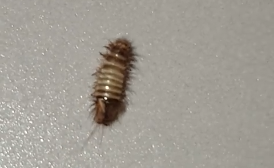Last week one of our technicians recorded some amazing footage of a carpet beetle larvae, often called a ‘Woolly Bear’.
To see that footage, click here.
In the UK, carpet beetles and clothes moths are the biggest threat to our textiles. The most common type of carpet beetle is the Varied Carpet Beetle, but there are also the Fur Beetle and the Vodka Beetle (Attagenus smirnovi). Adult Varied Carpet Beetles range in size between 1.7mm and 3.5mm. They are quite small, oval in shape, and looks somewhat like a mottled brown, grey and cream ladybird.
While they may be called carpet beetles, the adult beetle does not actually represent a threat to your carpets. They feed only on pollen and nectar, preferring flower heads such as Spirea and hogweed. The problem is, they lay their eggs in places such as birds’ nests, fabrics and the fluff that accumulates around the home. When those eggs hatch, the larvae will eat discarded feathers, fabrics and the fluff. They will move around the house looking for fresh sources of material/food. They can do some serious damage to an airing cupboard full of blankets.
How will you know if you have an infestation of carpet beetles?
Infestations are often identified either by seeing the adult carpet beetles or by seeing the damage caused by the larvae. Adults will be seen crowding around windows or sources of light. They can fly but could also be seen crawling towards lights.
It is also quite common to see the damage caused by the woolly bears. This normally consists of well-defined round holes, often along the seams of the fabric. This is where the grubs bite through the threads. Heavily infested areas will have several holes.
You might also find the discarded skins of the growing larvae.
When will I have a problem with carpet beetles?
The carpet beetle is quite a resilient creature. In its larvae form, it can survive starvation for several months. In total, the life cycle for the beetle is around a year. You will often see the adult form between April and June and then have the main problems with the larvae in October. After this, they will overwinter largely undetected.
Getting rid of carpet beetles
The most important thing to do it remove sources of food for the larvae. This will mean going into your property’s loft and eaves to remove old birds’ nests and dead birds. Fluff and debris should be vacuumed from airing cupboards, floorboards, upholstery, carpets, etc. While it can seem a rather extreme measure, you may also need to lift carpets and underlay and clean the areas underneath.
If you feel you have a serious infestation, then you should get in professional help. Treating a large infestation of woolly bears will require insecticides and, as I’ve detailed in previous blogs, the use of these chemicals by untrained individuals is having a negative impact on the environment and on pest resistance.
A professional pest controller can help you deal with the infestation, making sure the treatment is used safely. They will make sure it goes between floorboards, under the carpet and into crevices where insects may hide. They should also be able to remove bird detritus in the loft and help you bird-proof your property. This will not only help to stop infestations of pests like carpet beetles and bed bugs, it will also stop the damage birds can do in you loft to rafters, etc. Parakeets, for example, can do an amazing amount of damage when they are allowed to access a loft.
As with all domestic pests, the first remedy is cleanliness and tidying up. It is often easier to stop an infestation than deal with it once it has happened. Because the main entry point for carpet beetles is often birds’ nests, the first thing to do is to safely and legally stop birds accessing your property.
Final note of caution: if you think you have an infestation of woolly bears, be careful! Their hairy bodies will irritate your skin.
At Cleankill, we have considerable experience in dealing with carpet beetles and other pests (bed bugs, clothes moths, etc.). To contact us, call 0333 920 3695 or click here.
